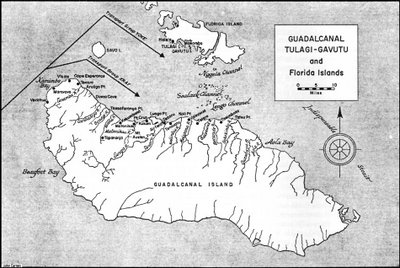 on the last post we finished up with the introduction. This is part one of the :
on the last post we finished up with the introduction. This is part one of the :FIRST OFFENSIVE: The Marine Campaign for Guadalcanal
by Henry I. Shaw, Jr.
The Landing and August Battles
On board the transports approaching the Solomons,
The Marines were looking for a tough fight. They knew little about the targets, even less about their opponents. Those maps that were available were poor, constructions based upon outdated hydrographic charts and information provided by former island residents. While maps based on aerial photographs had been prepared they were misplaced by the Navy in Auckland, New Zealand, and never got to the Marines at Wellington.
On 17 July, a couple of division staff officers, Lieutenant Colonel Merrill B. Twining and Major William McKean, had been able to join the crew of a B-17 flying from Port Moresby on a reconnaissance mission over Guadalcanal. They reported what they had seen, and their analysis, coupled with aerial photographs, indicated no extensive defenses along the beaches of Guadalcanal's north shore.
This news was indeed welcome. The division intelligence officer (G-2), Lieutenant Colonel Frank B. Goettge, had concluded that about 8,400 Japanese occupied Guadalcanal and Tulagi. Admiral Turner's staff figured that the Japanese amounted to 7,125 men. Admiral Ghormley's intelligence officer pegged the enemy strength at 3,100—closest to the 3,457 actual total of Japanese troops; 2,571 of these were stationed on Guadalcanal and were mostly laborers working on the airfield.
To oppose the Japanese, the Marines had an overwhelming superiority of men. At the time, the tables of organization for a Marine Corps division indicated a total of 19,514 officers and enlisted men, including naval medical and engineer (Seabee) units. Infantry regiments numbered 3,168 and consisted of a headquarters company, a weapons company, and three battalions. Each infantry battalion (933 Marines) was organized into a headquarters company (89), a weapons company (273), and three rifle companies (183). The artillery regiment had 2,581 officers and men organized into three 75mm pack howitzer battalions and one 105mm howitzer battalion. A light tank battalion, a special weapons battalion of antiaircraft and antitank guns, and a parachute battalion added combat power. An engineer regiment (2,452 Marines) with battalions of engineers, pioneers, and Seabees, provided a hefty combat and service element. The total was rounded out by division headquarters battalion's headquarters, signal, and military police companies and the division's service troops—service, motor transport, amphibian tractor, and medical battalions. For Watchtower, the 1st Raider Battalion and the 3d Defense Battalion had been added to Vandegrift's command to provide more infantrymen and much needed coast defense and antiaircraft guns and crews.
Unfortunately, the division's heaviest ordnance had been left behind in New Zealand. Limited ships' space and time meant that the division's big guns, a 155mm howitzer battalion, and all the motor transport battalion's two-and-a-half-ton trucks were not loaded. Colonel Pedro A. del Valle, commanding the 11th Marines, was unhappy at the loss of his heavy howitzers and equally distressed that essential sound and flash-ranging equipment necessary for effective counterbattery fire was left behind. Also failing to make the cut in the battle for shipping space, were all spare clothing, bedding rolls, and supplies necessary to support the reinforced division beyond 60 days of combat. Ten days supply of ammunition for each of the division's weapons remained in New Zealand.
to be continued.
Click here for the source this was COPIED from.
No comments:
Post a Comment